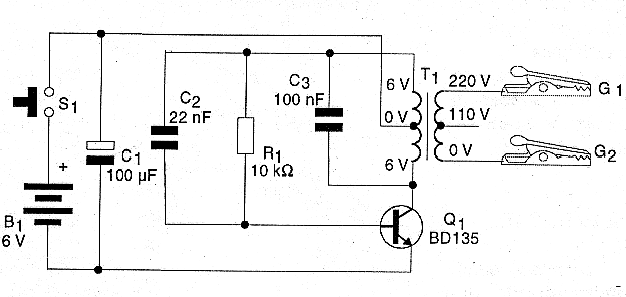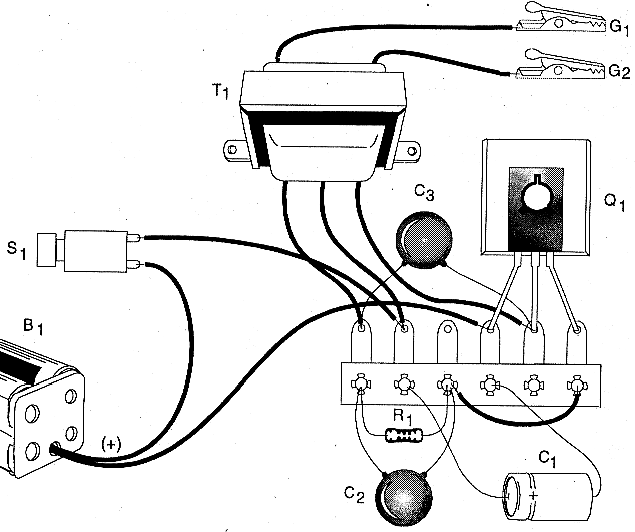At a science fair or as schoolwork, this circuit serves to demonstrate the working principle of transformers and inverters that can increase the voltage of batteries to light fluorescent lamps or even power other devices.
Note, however, that the electrified object must be isolated from the earth and that the device, if possible, must be activated for short periods of time, as its consumption is high.
The project basically consists of a small inverter powered by 4 small or medium batteries. The transformer used has a 110 V or 220 V winding, but the voltage obtained can exceed this value because the signal waveform is not sinusoidal.
HOW IT WORKS
A transformer can increase or decrease the voltage according to the number of turns of each of its windings. Thus, if the secondary of a transformer has 100 times more turns of wire than the primary, if we apply 1.5 V on the primary, we will have 150 volts on the secondary.
However, transformers do not operate with direct currents like those that can supply batteries. The currents must vary quickly to be able to induce voltages in the other winding of a transformer.
For this reason, transformers are used in alternating current circuits.
To use a transformer with batteries, we must add a circuit that changes the current in the battery, and in our case this circuit is an oscillator with a transistor. This oscillator then generates the current variations that allow the induction of high voltage in a common transformer.
ASSEMBLY
In figure 1 we have the complete diagram of the device.

The arrangement of components on a terminal bridge is shown in figure 2.

The transistor needs a small heat radiator and supports equivalents with the DV137 or BD139. The resistor is 1/8 watt and capacitor C1 is an electrolytic for 12 volts or more. The other capacitors can be ceramic or polyester.
The transformer has a primary winding of 110/220 V and a secondary winding of 6 + 6 V with a current of 50 to 300 mA.
TEST AND USE
To test the device, just press C1 and hold the alligator clips. There must be a strong shock.
To use, connect clamp G1 on the object you want to electrify and clamp G2 to a ground that may be another metal object in contact with the ground.
When pressing S1, electrification occurs.
If you notice low performance, change the value of R1 in the range from 4.7 k ohms to 47 k ohms, in order to obtain the highest performance.
WHAT TO EXPLAIN
Explain how a transformer works. Show how the voltage appears in the secondary winding and that this component needs current variations.
Show that the inverters cannot create energy and that if the voltage can be increased, the current decreases keeping the power constant.
OTHER USES
Coupled with an alarm or touch switch, this circuit can electrify the object to be protected when someone touches it or when someone enters somewhere.
Connecting a small fluorescent lamp (up to 15 watts) at the output of this circuit it should light up.
Semiconductors:
Q1 - BD135 or equivalent - medium power NPN transistor
Resistors: (1/8 watt, 5%)
R1 - 10 k ohm - brown, black, orange
Capacitors:
C1 - 100 uF / 12V - electrolytic
C2 - 22 nF (223 or 0.022) - ceramic or polyester
C3 - 100 nF (104 or 0.1) - ceramic or polyester
Several:
B1 - 6 V - 4 small batteries
S1 - NA pressure switch
T1 - Transformer with 110/220 V primary and 6 + 6 V secondary and 50 to 300 mA current
G1, G2 - alligator clips
Terminal bridge, mounting box, battery holder, transistor heat radiator, wires, solder, etc.



